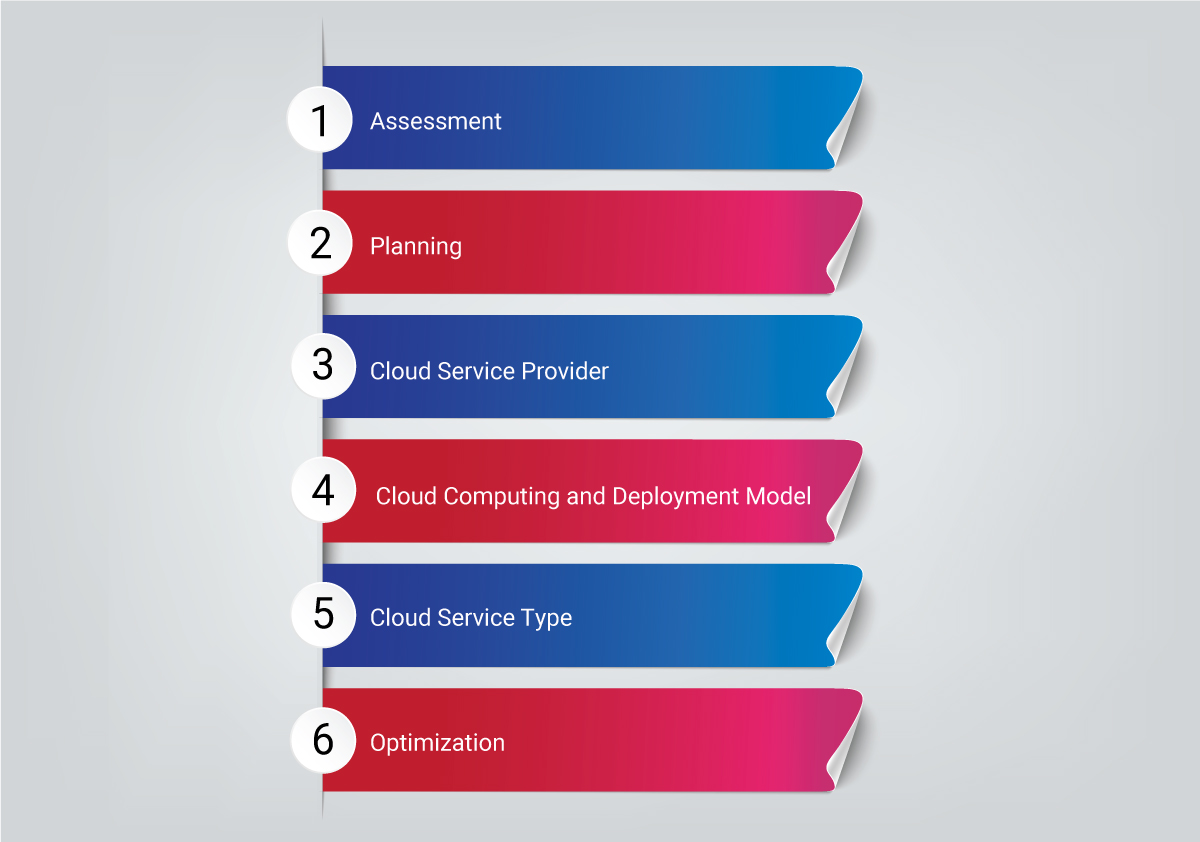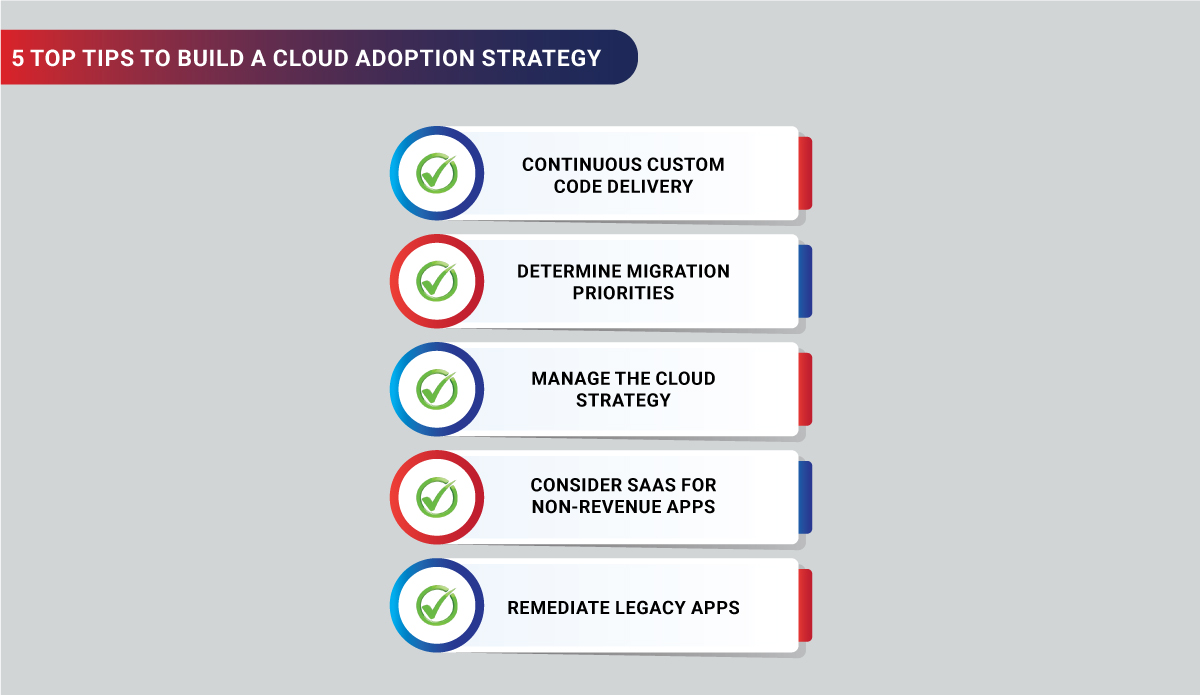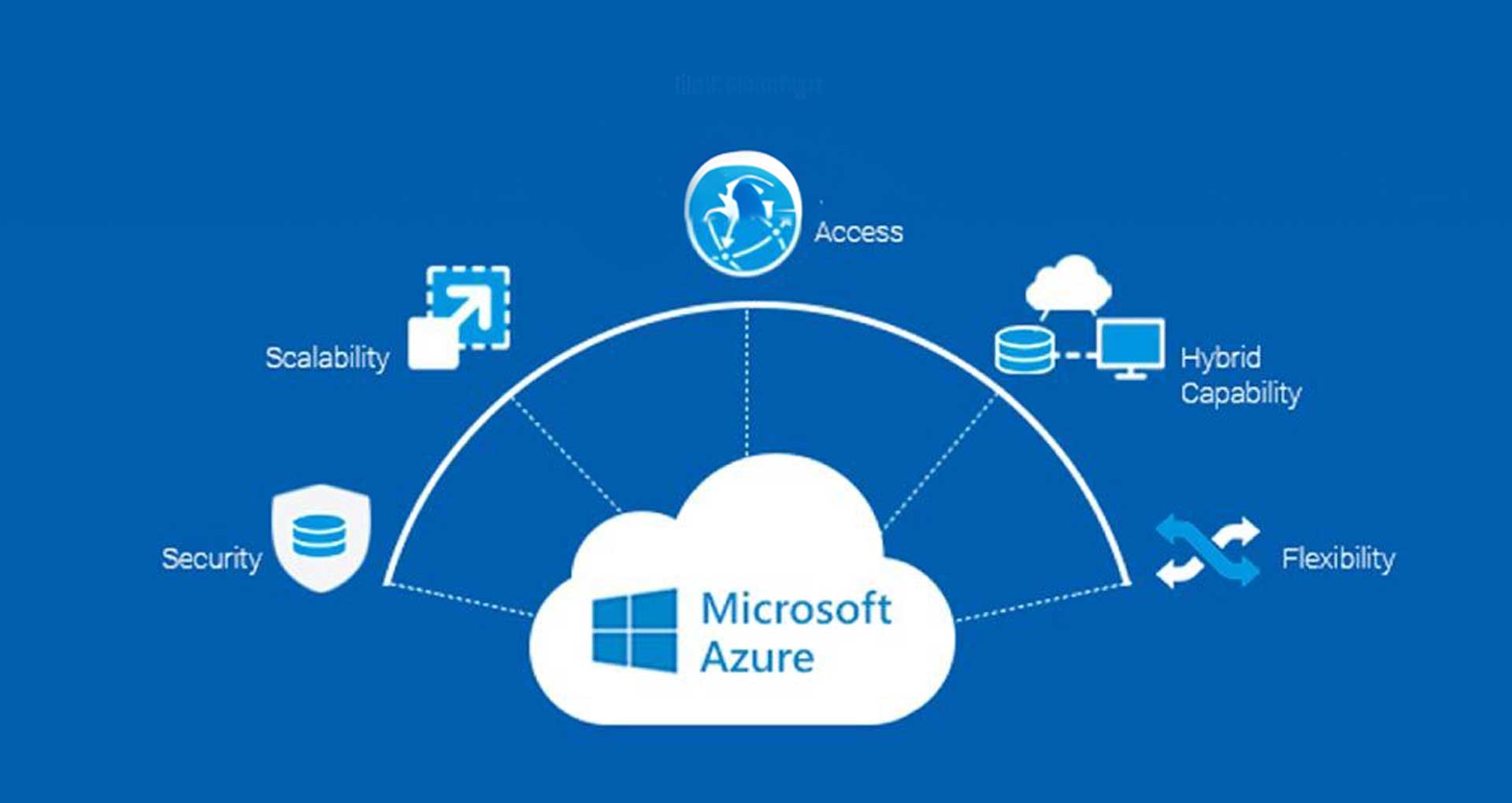We are witnessing a scenario where adopting cloud computing models helps businesses automate their processes, enable innovation, and enhance agility across the organization. Adoption is proving to be a game changer with expansion into new market reach, cost reduction, and accelerated time to market.
However, we often encounter scenarios where most businesses rush into cloud adoption without a clear strategy. It leads to issues like process complexities, wasteful spending, critical security threat, and compliance problems. Businesses that have successfully migrated to the cloud and modernized their digital assets followed a well-structured plan for cloud adoption.
This blog will explore the concept of enterprise cloud adoption strategy, why businesses need it, the approaches and elements of a cloud strategy, steps to create one, and the challenges and tips of cloud adoption in 2023.
So, let’s begin!
What is a Cloud Adoption Strategy?
Cloud adoption strategy includes your business goals and the steps to move your digital assets to the cloud. The successful transition of your business to the cloud depends on its accuracy, details, and execution. It is the foundation for enabling your company to understand and govern cloud usage.
You can enhance integration and automation capabilities by modernizing systems and migrating data and workloads to the cloud. Businesses are more likely to make random choices that do not align with their cloud objectives without a clear strategy. So, having an expertly structured and well-thought-out cloud strategy would boost productivity and efficiency while achieving your business goals.
Did you know?
- Over 85% of businesses will adopt the Cloud-first approach by 2025 and will execute digital strategies using cloud-native technologies and architecture, says Gartner[1].
- According to a Markets and Markets report, the global cloud computing market could grow at a CAGR of 17.9% from USD 545.8 bn in 2022 to USD 1249 bn by 2027[2].
- Large enterprises want to have around 60% of their IT environment on the cloud by 2025[3]. And cloud adoption could generate USD 3 Trillion in EBITDA value for Forbes Global 2000 companies by 2030, confirms a McKinsey study.
Why do Businesses Need a Cloud Adoption Strategy?
A well-planned enterprise cloud adoption strategy ensures a smooth migration to the cloud and maximizes advantages. It outlines the reasons for adopting cloud solutions, what they entail, and how to do it. With such a strategy, your technological solution could be cohesive with better-configured environments, increasing business risks.
You must craft a sound cloud strategy to define business goals, identify the key benefits of using cloud technology, create a roadmap, and determine which cloud services will be ideal for your business.
Who Needs to Adopt Cloud and Why?
Utilizing cloud storage, computing, and applications benefits the following entities:
Startups
Cloud adoption helps startups save costs by avoiding upfront investments into costly IT infrastructure. Instead of paying for software and license, they can use SaaS (Software as a Service) pay-as-you-go model and spend only for the resources they use.
Small and Medium-sized Enterprises
The cloud offers small and medium-sized companies easy, quick, and cost-effective scalability. It prevents them from investing in expensive hardware and software upgrades as they grow. Instead, it helps them scale up by adding cloud components or scale down by deleting services without paying fees or penalties.
Large Enterprises
Big players can reap more considerable benefits by moving to the cloud. It offers cost-effectiveness with low infrastructure investment and reduced maintenance against building, maintaining, and securing a sizeable on-premises IT infrastructure. Cloud computing provides several business applications that meet large enterprises’ needs to scale advanced automation across the organization and add intelligence to workflows, allowing their employees to operate more efficiently.
Approaches of Cloud Adoption
Businesses are increasingly prioritizing cloud usage over on-premise IT solutions. The different approaches to cloud adoption include the following:

Cloud-First Strategy
It gives importance to developing apps and IT solutions on the cloud instead of on-premise to meet current and future business and IT needs.
Cloud-Only Approach
Companies adopting this approach rely solely on the cloud (typically the public cloud) for all IT needs. They can implement cloud-only strategies by utilizing a combination of cloud-based services like PaaS (Platform as a Service), IaaS (Infrastructure as a Service), and SaaS (Software as a Service).
Cloud Native Adoption
It is a strategic approach to building and running applications using cloud technologies to mitigate risk, reduce cost and achieve scalability of database capabilities. Cloud security vendors offer inherent automation and agility due to their procedures and principles. Cloud-native adoption supports fast and frequent changes to the application, thus providing companies with a competitive advantage. To know more, check out our in-detail guide on the benefits of cloud-native applications and how to get started.
Elements of an Enterprise Cloud Adoption Strategy
A successful cloud strategy revolves around five essential elements, including the following:
Element #1: Align your Cloud Strategy with the Overall Business Strategy
Your cloud strategy must closely align with your business objectives. Establishing the ‘Why you want to move to the cloud?’ will help you prioritize the potential impacts of cloud adoption. Documenting the business outcomes will help the organization show results and ensure success in the long run.
Cloud adoption requires investment in people and resources, so aligning it with the overall business strategy will foster the right level of executive sponsorship, the support needed from IT, and the required support from other business areas. When building a cloud strategy, you can also set up objectives and key results to better track how it supports your overall business goals, improves efficiency, reduces costs, enhances agility, and maintains appropriate security and compliance.
Element #2: Risk Assessment and Mitigation
Risk management is critical to the success of your cloud journey to ensure cloud adoption does not introduce any threats or risks to the organization. You must therefore assess and plan for five key types of risks – security, compliance, agility, availability, and supplier risks to mitigate potential roadblocks or challenges.
Element #3: Look Beyond Cost Reduction
Don’t make cost reduction your sole focus for cloud adoption. Factors such as increased infrastructure spending, the rising cost of running a parallel IT footprint, and labor shortage can spiral the costs. Other factors to consider instead of cost reduction are maximizing cloud benefits, innovation, revenue growth, customer experience, and risk management.
Explore smarter cost management in the AWS cloud with our expert-led eBook.
Element #4: Plan for Different Cloud Routes
While many possible routes to the cloud exist, the most popular ones, also called the 6R’s of the Cloud Migration Strategy, include rehosting, re-platforming, repurchasing, refactoring, retiring, and retaining. You must choose the approach that best suits your business needs and ensure smooth cloud adoption.
Element #5: Understand the Shared Responsibility Model
When creating a cloud implementation strategy, it is essential to understand that both you and the cloud provider will share the responsibility for the smooth operations of the cloud. The cloud provider’s responsibility is to offer services, and you must ensure that you leverage them to achieve the desired results and maximize cloud benefits.
Steps for Creating a Successful Cloud Adoption Strategy
Developing a cloud strategy is a complex process that involves specific steps. To ensure your strategy is reliable, you must thoroughly complete each step before moving on to the next. Taking expert guidance could help in creating a winning cloud strategy.

Step 1. IT Infrastructure Assessment
The first step starts with assessing your IT infrastructure before developing a successful enterprise cloud adoption strategy. At this step, the cloud consultant identifies roadblocks and discovers opportunities for efficient cloud deployment.
Step 2. Planning for Important Components in Enterprise Cloud Strategy
In this step, it is required to identify an essential roadmap. Before you choose the most suitable cloud model – public, private, or hybrid and the most appropriate cloud approach, SaaS, IaaS, PaaS, or a combination, you must ensure that your business and cloud needs are being fulfilled. In this step, the purpose is to map elements considering scalability, reliability, and maintainability checklist.
Step 3. Select the Right Cloud Service Provider
Before making a choice, it’s essential to research, dig up and learn about the different cloud service providers. Here you should ensure that the cloud provider you choose is reliable and has a presence locally and globally. Microsoft Azure, Amazon Web Services (AWS), and Google Cloud are the most popular, secure, and reliable cloud service providers.
Step 4. Determine the Cloud Computing Deployment Model
Cloud deployment models are categorized into public, private, hybrid, and multi-cloud. Let us quickly walk you through how to choose the suitable deployment model.
- Public Cloud: The public cloud is being adopted for less-sensitive applications, and it helps businesses to take advantage of higher scalability, flexibility, lower cost, and access to next-gen technologies.
- Private Cloud: Businesses prioritizing security and not wanting to compromise on the data or rely on third-party hosted solutions prefer to go with private cloud.
- Hybrid Cloud: A hybrid cloud is preferred to cloud or non-cloud solutions for greater flexibility, scalability, compliance, and getting the most out of existing infrastructure.
- Multi-Cloud: If you are adopting digital transformation, a multi-cloud strategy is the most preferred choice to deploy public, private, and edge cloud apps.
For an in-depth exploration of cloud computing deployment models and their distinctions, delve into our comprehensive articles comparing multi-cloud vs hybrid cloud, as well as private cloud vs public cloud.
Step 5. Select the Right Type of Cloud Service
You can select the appropriate cloud computing models from the following:
- IaaS (Infrastructure as a Service): The service provider will host infrastructure associated with on-premises data centers like servers, storage, networking, and virtualization. Popular IaaS examples include Amazon Web Services (AWS), IBM Cloud, and Microsoft Azure.
- SaaS (Software as a Service): SaaS is a cloud-based software delivery model that delivers applications over the Internet. You can access the apps through a third-party vendor who manages the infrastructure rather than installing and maintaining software on-premise. Examples include Salesforce, Google Workspace, and Adobe CC.
- PaaS (Platform as a Service): PaaS is an ideal cloud service for end-to-end development and deployment tools, capabilities, and environment. PaaS offers a platform, development tools, and underlying infrastructure to write code and test solutions online. Google App Engine and Heroku are the most popular examples of PaaS.
Step 6. Optimization
Creating an enterprise cloud computing strategy involves fine-tuning the system to leverage available resources better. By optimizing business processes and software licenses, you can deliver more value to your company and customers. You can create a clear roadmap and assemble a skilled workforce at this stage.
Cloud Adoption Challenges and Solutions to Overcome Them
While moving to the cloud can pose some business concerns, you can effectively address and overcome them with the right cloud adoption strategy.
- Security and Privacy: The security of confidential data is a top concern for organizations moving to the cloud. Reputable public cloud providers like AWS and Azure invest heavily in cybersecurity. They offer better protection against cyber threats than individual companies or government agencies.
- Vendor Lock-in: Companies often worry about being tied to a single vendor. You can resolve it by implementing a multi-cloud solution. It allows flexibility in transitioning between service providers and helps you benefit from the declining cost of cloud services.
- Governance and Compliance: Specific industries like healthcare are highly regulated. So, compliance and governance pose concerns for organizations. You can address this challenge by aligning your cloud strategy with industry regulations, policies, and procedures.
- ROI and Cost Structure: Cost is often a concern for businesses moving to the cloud. They have the experience of investing one-time for on-premise solutions, whereas cloud models are based on recurring costs. The on-premise deployment also has hidden expenses of maintaining and upgrading them regularly. Contrarily, the cloud eliminates these expenses and is comparatively cost-effective in the long run.
- Skill Gaps: The lack of in-house cloud expertise poses a significant challenge for companies. According to Statista[4], a lack of qualified staff is the biggest challenge to faster cloud adoption. You can overcome it by building a cross-functional cloud team or partnering with a cloud adoption specialist company to manage the transition and infrastructure costs.
Cloud Adoption Strategy Tips
Here are some tips that can help you create an effective enterprise cloud adoption strategy:

Continuous Custom Code Delivery
Businesses need continuous software development and agile DevOps practices to compete effectively in the digital space. You can build a successful cloud strategy by prioritizing infrastructure-as-a-service (IaaS) and containers to support agile development and enable continuous delivery.
Determine Migration Priorities
When moving apps to the cloud, you need to select apps that are flexible to ensure cost savings. So, it is advisable to choose apps with highly variable usage; else, you will have to pay extra for on-premises resources you don’t need. Other factors to consider in application migration are suitability of serverless computing the shortcoming of migration, and impact on interdependent apps.
Manage the Cloud Strategy
Cloud technology is also an operating model; you must customize provisioning and management processes to accommodate a hybrid approach. Ensure your security team understands cloud capabilities and policies for risk and compliance. You can streamline application management by centralizing cloud access.
Consider SaaS for Non-Revenue Apps
You can consider using Software-as-a-Service (SaaS) options for non-core apps that do not generate revenue. They could include email, CRM, helpdesk, and payroll. As a result, your IT team (in-house) can focus on core competitive aspects by outsourcing them.
Remediate Legacy Apps
It’s essential to assess your legacy applications. You should consider migrating legacy applications to the cloud if they are not performing efficiently. To minimize downtime and data loss, you must automate migration to new platforms, including IaaS. Ensure the process is smooth by aligning migration schedules with updates or replacements.
Why Avail Rishabh’s Cloud Strategy Services?
We at Rishabh Software are highly skilled at providing end-to-end cloud-based services for Microsoft Azure and Amazon Web Services. As a leading cloud development company, we can help you leverage the benefits of cloud computing to employ all the cloud capabilities efficiently.
From assessing your existing infrastructure to selecting the right cloud tech stack, we can help you create a secure and scalable digital solution to improve your business’s bottom line. Be it cloud implementation, legacy app modernization, cloud migration, or full-scope cloud application development services, count on us as your standard cloud consulting and development partner for leading cloud platforms.
Frequently Asked Questions
Q: How can cloud adoption strategy benefit businesses?
A: By creating a well-structured and thorough cloud adoption strategy, you can significantly improve your cloud project’s outcome:
- Cost Reduction: You need not invest capital upfront for IT infrastructure and reduce operational expenses. By adopting the pay-as-you-go cloud model, you can pay only for the resources you use. Besides, the cloud also helps you save on infrastructure provisioning and setup, maintenance and backup, and administration costs.
- Agility and Scalability: The cloud provides on-demand scaling and easy data sharing. You can leverage these benefits by creating an effective cloud adoption strategy. Cloud platforms also offer tools to enhance business agility and adaptability to changing demands.
- Simplified Processes: Cloud-based solutions can simplify and automate routine IT and administrative tasks. It results in smooth business operations and seamless interactions between teams and departments. With cloud services, you can conduct continuous testing and drive innovations across your organization.
Q: Explain how are different industries adopting cloud services?
A: Industries are increasingly adopting cloud platforms and services and exploring new use cases to leverage its many benefits. These industries include:
- Healthcare: Cloud computing provides several use cases in hospitals, clinics, and medical organizations. They use it for secure electronic health records (EHRs), document storage, marketing, and human resources.
- Insurance: There is significant cloud adoption in the insurance sector as it helps with automation and enhances insurance companies’ scalability, flexibility, and infrastructure agility.
- Marketing and Advertising: This dynamic industry leverages hybrid cloud strategies to deliver customer-relevant content swiftly on social media and other global platforms.
- Retail: The cloud offers scalable and flexible solutions that allow e-commerce companies to meet changing consumer needs. Retail and e-commerce companies that have adopted the cloud can enhance customer experience and achieve significant cost-efficiency by reducing their IT infrastructure and data storage costs.
- Finance: Financial institutions utilize cloud technology to optimize expense management, human resources, and customer communications. They do this by placing email platforms and marketing tools in the cloud. Check out this informative piece of content to explore the adoption and migration of cloud in the finance industry.
- Education: The cloud offers speed and agility to ed-tech providers to accelerate time to market quickly. Internet-based learning opportunities are flourishing, with cloud-enabled universities, private institutions, and K-12 schools providing online learning, homework, and grading systems.
Other industries that have adopted cloud adoption include construction, real estate, and not-for-profit sectors. Cloud computing brings transformative possibilities to every corner of the business landscape.
Footnotes:
2. https://www.marketsandmarkets.com/Market-Reports/cloud-computing-market-234.html
4. https://www.statista.com/statistics/1172299/biggest-barriers-holding-back-cloud-adoption/











 30 Min
30 Min


